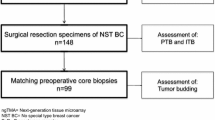PURPOSE
The aim of this study was to assess the intensity of tumor budding in colon carcinoma quantitatively and to determine its correlation with malignancy potential.
METHODS
The intensities of tumor budding at the invasive front of surgical specimens from 174 patients with well-differentiated or moderately differentiated colon carcinoma were investigated. Differences in intensity among clinicopathologic parameters were compared, and recurrences and survivals were analyzed in accordance with degree of the intensity.
RESULTS
Tumor budding was identified in 155 patients (89 percent) and the mean intensity (± standard deviation) of budding was, on the whole, 6.6 ± 5.6. Intensity was significantly higher in tumors with lymphatic and vascular invasion than in those without (9.1 ± 6.6 vs. 4.8 ± 3.9 and 9.8 ± 6.1 vs. 5.4 ± 4.9; P < 0.0001, respectively). It became significantly higher with increasing T and N stage (P = 0.0013 and < 0.0001, respectively). Both the Cox model and the linear logistic regression indicated that higher intensity was significantly associated with higher risk of postoperative recurrence (P = 0.017 and 0.0001, respectively). When patients were stratified into four groups based on the quartiles of the distribution of intensity, the group of higher quartiles showed significantly less favorable outcome in terms of both five-year disease-free (P = 0.0039) and overall survival (P = 0.0263). The cutoff of the intensity considered to be the best indicator for separating patients with regard to survival was third quartiles (intensity, 9). Based on multivariate analysis, the intensity of budding proved to be a significant covariate associated with disease-free survival (hazard ratio, 2.061; P = 0.0066).
CONCLUSIONS
The intensity of tumor budding at the invasive margin is suggested to be a significant pathologic index, indicating higher malignancy potential and the intensity greater than nine may be considered an adverse prognostic indicator in patients with colon carcinoma.


Similar content being viewed by others
REFERENCES
T Morodomi H Isomoto K Shirouzu K Kakegawa K Irie M Morimatsu (1989) ArticleTitleAn index for estimating the probability of lymph node metastasis in rectal cancers. Lymph node metastasis and the histopathology of actively invasive regions of cancer Cancer 63 539–43 Occurrence Handle2912530
K Hase C Shatney D Johnson M Trollope M Vierra (1993) ArticleTitlePrognostic value of tumor “budding” in patients with colorectal cancer Dis Colon Rectum 36 627–35 Occurrence Handle8348847
T Okuyama M Oya H Ishikawa (2003) ArticleTitleBudding as a useful prognostic marker in pT3 well- or moderately-differentiated rectal adenocarcinoma J Surg Oncol 83 42–7 Occurrence Handle10.1002/jso.10230 Occurrence Handle12722096
H Ueno J Murphy JR Jass H Mochizuki IC Talbot (2002) ArticleTitleTumour ‘budding’ as an index to estimate the potential of aggressiveness in rectal cancer Histopathology 40 127–32 Occurrence Handle10.1046/j.1365-2559.2002.01324.x Occurrence Handle11952856
M Tanaka Y Hashiguchi H Ueno K Hase H Mochizuki (2003) ArticleTitleTumor budding at the invasive margin can predict patients at high risk of recurrence after curative surgery for Stage II, T3 colon cancer Dis Colon Rectum 46 1054–9 Occurrence Handle10.1007/s10350-004-7280-z Occurrence Handle12907899
T Okuyama M Oya H Ishikawa (2002) ArticleTitleBudding as a risk factor for lymph node metastasis in pT1 or pT2 well-differentiated colorectal adenocarcinoma Dis Colon Rectum 45 628–34 Occurrence Handle10.1007/s10350-004-6259-0 Occurrence Handle12004212
Jass JR, Sobin LH. Histologic typing of intestinal tumors. In WHO international histological classification of tumors. 2th ed. Berlin: Springer-Verlag, 1989
CE Dukes (1932) ArticleTitleThe classification of cancer of the rectum J Pathol Bacteriol 35 323–32
DR Cox (1972) ArticleTitleRegression models and life tables J R Stat Soc Series B 34 187–220
McCullagh P, Nelder JA. Generalized linear models. 2nd ed. London: Chapman and Hall, 1989
N Mantel (1966) ArticleTitleEvaluation of survival data and two new rank order statistics arising in its consideration Cancer Chemother Rep 50 163–70 Occurrence Handle5910392
T Imai (1954) ArticleTitleThe growth of human carcinoma: a morphological analysis [in Japanese] Fukuoka Igaku Zasshi 45 72–102
K Hase CH Shatney H Mochizuki et al. (1995) ArticleTitleLong-term results of curative resection of “minimally invasive” colorectal cancer Dis Colon Rectum 38 19–26 Occurrence Handle7813339
CR Teixeira S Tanaka K Haruma et al. (1994) ArticleTitleCarcinoembryonic antigen staining patterns at the invasive tumor margin predict the malignant potential of colorectal carcinoma Oncology 51 228–33 Occurrence Handle7515172
PC Nowell (1986) ArticleTitleMechanisms of tumor progression Cancer Res 46 2203–7 Occurrence Handle3516380
P Frost B Levin (1992) ArticleTitleClinical implications of metastatic process Lancet 339 1458–61 Occurrence Handle1351135
T Masaki H Matsuoka M Sugiyama et al. (2003) ArticleTitleLaminin-5 γ2 chain expression as a possible determinant of tumor aggressiveness in T1 colorectal carcinomas Dig Dis Sci 48 272–8 Occurrence Handle12643602
T Masaki A Goto M Sugiyama et al. (2001) ArticleTitlePossible contribution of CD44 variant 6 and nuclear beta-catenin expression to the formation of budding tumor cells in patients with T1 colorectal carcinoma Cancer 92 2539–46 Occurrence Handle11745187
T Masaki M Sugiyama H Matsuoka et al. (2003) ArticleTitleCoexpression of matrilysin and laminin-5 gamma2 chain may contribute to tumor cell migration in colorectal carcinomas Dig Dis Sci 48 1262–7 Occurrence Handle12870781
I Sordat P Rousselle P Chaubert et al. (2000) ArticleTitleTumor cell budding and laminin-5 expression in colorectal carcinoma can be modulated by the tissue micro-environment Int J Cancer 88 708–17 Occurrence Handle11072238
R Simon DG Altman (1994) ArticleTitleStatistical aspects of prognostic factor studies in oncology Br J Cancer 69 979–85 Occurrence Handle8198989
T Okuyama M Oya M Yamaguchi (2002) ArticleTitleBudding (Sprouting) as a useful prognostic marker in colorectal mucinous carcinoma Jpn J Clin Oncol 32 412–6 Occurrence Handle12451038
Author information
Authors and Affiliations
Corresponding author
Additional information
Dr. Choi was supported by the Dong-A University Research Fund in 2004, and Dr. Kim was supported by the Korea Science and Engineering Foundation Grant (R14-2003-002-01000-0).
About this article
Cite this article
Park, KJ., Choi, HJ., Roh, MS. et al. Intensity of Tumor Budding and Its Prognostic Implications in Invasive Colon Carcinoma. Dis Colon Rectum 48, 1597–1602 (2005). https://doi.org/10.1007/s10350-005-0060-6
Published:
Issue Date:
DOI: https://doi.org/10.1007/s10350-005-0060-6




